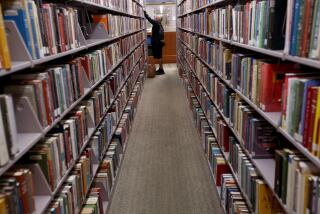Reagan library items likely lost or pilfered
- Share via
WASHINGTON — The Ronald Reagan Presidential Library is unable to find or account for tens of thousands of valuable mementos of Reagan’s White House years because a “near universal” security breakdown left the artifacts vulnerable to pilfering by insiders, an audit by the National Archives inspector general has concluded.
Inspector General Paul Brachfeld said that his office was investigating allegations that a former employee stole Reagan memorabilia but that the probe had been hampered by the facility’s sloppy record-keeping.
“We have been told by sources that a person who had access capability removed holdings,” Brachfeld said in an interview. “But we can’t lock in as to what those may be.”
The hilltop complex near Simi Valley that houses Reagan’s papers -- as well as the Air Force One that served as the “Flying White House” for seven presidents -- is the most visited of the nation’s 12 presidential libraries. Many of those facilities are understaffed. And many are struggling to keep track of hundreds of thousands of presidential gifts, including valuable objects bestowed by foreign leaders, American folk crafts, and T-shirts and political buttons.
But, investigators said, they encountered the most serious problems at the Reagan library, a finding that may mortify fans of the late president, who often inveighed against government inefficiency.
About six months ago, an archivist was accused of stealing from the collections and was fired, said a longtime volunteer at the library who asked not to be named for fear of reprisal. “It’s just awful,” she said. “He was someone in a position of trust.”
Of particular interest is whether the artifacts that are unaccounted for include pieces from a large collection of ornamented Western belt buckles given to Reagan over the years by admirers who knew of his attachment to his ranch.
A National Archives spokeswoman said the agency had accepted the audit’s criticisms and was working to fix the problems. Some library volunteers say they were called in this summer to start a massive inventory project that could take years to complete.
The theft of historical objects from library collections has become a serious problem across the country in recent years. Against that background, Sen. Charles E. Grassley (R-Iowa) pushed for the audit of presidential libraries. He feared that artifacts associated with former presidents might attract thieves seeking to supply a burgeoning market for memorabilia.
“This report is a wake-up,” Grassley said. “These papers, records and other items have historical value and should be safeguarded for the education and benefit of future generations of Americans.”
Most gifts to presidents become property of the American people, and presidential libraries use them to tell a story in ways that documents alone cannot. The gifts are considered part of the libraries’ museum collections. The Reagan library, for example, has displayed some of the belt buckles given to the former president, and an exhibit of First Lady Nancy Reagan’s dresses and suits will be staged this week.
The audit found that the Reagan library was unable to properly account for more than 80,000 artifacts out of its collection of some 100,000 such items, and “may have experienced loss or pilferage the scope of which will likely never be known.”
It blamed the problem on lack of supervision, concluding that “adequate management controls were neither implemented nor properly monitored.”
It also found numerous storage lapses, such as artworks stacked on top of one another, and sculptures and vases unwrapped and lying on their sides on open shelves -- in an area prone to earthquakes.
Auditors tried to locate a sample of 21 items from a larger list of “high-value objects.” One was missing -- a vase -- even though library records indicated it was accounted for.
And nine of 26 items in two as-yet unpacked boxes had gone missing. Among them: a hand-crocheted American flag and an elephant figurine.
Norma Stafford, a former docent at the library, recalls that the huge basement warehouse used to store gifts was in disarray during the years she volunteered there.
“There were lots of boxes that seemed to be stacked upon one another. . . . They had been pulled out of their place and not put back,” Stafford said. The audit found records indicating dozens of items were on display, when in fact the exhibits had been taken down, in some cases years ago.
Shelly Hale, a current docent, said she was called to the library in August for an urgent chore. She was told the library was installing a computer system to track each of the 100,000 gifts stored in the warehouse.
But first the library needed help refiling documents indicating who had checked out a particular item. There were “stacks and stacks” of unfiled papers, she said, each pertaining to an individual artifact.
National Archives spokeswoman Susan Cooper said the agency welcomed the audit and was taking its findings very seriously. Part of the problem, she said, is that presidential libraries originally did not have the same strict preservation guidelines used by most museums. That has been corrected, she said, but funding for the libraries is still an issue.
“Our resources are spread pretty thin,” Cooper said. “We are trying very hard to ameliorate this situation. We are looking at these recommendations and trying to put them into play.”
--
ricardo.alonso-zaldivar@ latimes.com
catherine.saillant@latimes.com
Alonso-Zaldivar reported from Washington and Saillant from Ventura County.
More to Read
Sign up for Essential California
The most important California stories and recommendations in your inbox every morning.
You may occasionally receive promotional content from the Los Angeles Times.














